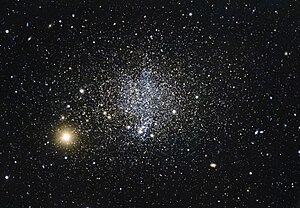Phoenix-Zwerggalaxie
| Galaxie Phoenix-Zwerggalaxie | |
|---|---|
 | |
| Die Phoenix-Zwerggalaxie aufgenommen mithilfe des Instruments FORS2 am Very Large Telescope | |
| AladinLite | |
| Sternbild | Phönix |
| Position Äquinoktium: J2000.0, Epoche: J2000.0 | |
| Rektaszension | 01h 51m 06,3s[1] |
| Deklination | −44° 26′ 41″[1] |
| Erscheinungsbild | |
| Morphologischer Typ | dIAm[1] |
| Helligkeit (visuell) | 13,1 mag |
| Winkelausdehnung | 4,9′ × 4,1′[1] |
| Physikalische Daten | |
| Zugehörigkeit | Lokale Gruppe |
| Radialgeschwindigkeit | (60 ± 30) km/s[1] |
| Entfernung | (1.440.000 ± 70.000) Lj / (440.000 ± 20.000) pc [2][3] |
| Geschichte | |
| Entdeckung | Hans-Emil Schuster, Richard Martin West[1] |
| Entdeckungsdatum | 1976[1] |
| Katalogbezeichnungen | |
| PGC 6830 • ESO 245-G7 • SGC 014903-4441.5 • AM 0149-444 | |
Die Phoenix-Zwerggalaxie ist eine irreguläre Zwerggalaxie im Sternbild des Phönix, die 1976 von Hans-Emil Schuster und Richard Martin West entdeckt und zunächst fälschlicherweise für einen Kugelsternhaufen gehalten wurde.[4][5] Sie befindet sich in einer Entfernung von etwa 0,44 Mpc von der Erde und gehört zur Lokalen Gruppe.
Eigenschaften
Die Phoenix-Zwerggalaxie besitzt in ihrer Zentralregion eine Sternpopulation junger Sterne, die sich in einer Ost-West- und eine Population vor allem älterer Sterne in den Außenregionen der Galaxie, die sich in einer Nord-Süd-Richtung bewegen. Die Sternentstehungsrate in der Zentralregion scheint dabei relativ stabil konstant im Laufe der Entwicklungsgeschichte der Zwerggalaxie zu verlaufen (Martínez-Delgado et al. 1999). Im Jahr 1999 entdeckten St-Germain et al. ein H-I-Gebiet von etwa 105 M☉ direkt westlich der Phoenix-Zwerggalaxie. Dessen Radialgeschwindigkeit liegt bei etwa −23 km/s und zeigt wahrscheinlich eine gravitative Kopplung mit der Zwerggalaxie.[6]
Weiteres
- Liste der Satellitengalaxien der Milchstraße
- Liste der Galaxien der Lokalen Gruppe
Weblinks
- ESO: Ein explosiver Phönix 17. September 2018
Einzelnachweise
- ↑ a b c d e f NASA/IPAC Extragalactic Database
- ↑ I. D. Karachentsev, V. E. Karachentseva, W. K. Hutchmeier, D. I. Makarov: A Catalog of Neighboring Galaxies. In: Astronomical Journal. Band 127, Nr. 4, 2004, S. 2031–2068, doi:10.1086/382905, bibcode:2004AJ....127.2031K.
- ↑ Karachentsev, I. D.; Kashibadze, O. G.: Masses of the local group and of the M81 group estimated from distortions in the local velocity field. In: Astrophysics. Band 49, Nr. 1, 2006, S. 3–18, doi:10.1007/s10511-006-0002-6, bibcode:2006Ap.....49....3K.
- ↑ H.-E. Schuster, R. M. West: A very distant globular cluster? In: Astronomy and Astrophysics. Band 49, Mai 1976, S. 129–131, bibcode:1976A&A....49..129S.
- ↑ R. Canterna, P. J. Flower: A new dwarf irregular galaxy in the constellation Phoenix. In: Astrophysical Journal. Band 212, Letters, März 1977, S. L57–L58, doi:10.1086/182374, bibcode:1977ApJ...212L..57C.
- ↑ Sidney van den Bergh: Updated Information on the Local Group. In: The Publications of the Astronomical Society of the Pacific. Band 112, Nr. 770, April 2000, S. 529–536, doi:10.1086/316548, arxiv:astro-ph/0001040, bibcode:2000PASP..112..529V.
Auf dieser Seite verwendete Medien
Caption from NASA: Like early explorers mapping the continents of our globe, astronomers are busy charting the spiral structure of our galaxy, the Milky Way. Using infrared images from NASA's Spitzer Space Telescope, scientists have discovered that the Milky Way's elegant spiral structure is dominated by just two arms wrapping off the ends of a central bar of stars. Previously, our galaxy was thought to possess four major arms.
This artist's concept illustrates the new view of the Milky Way, along with other findings presented at the 212th American Astronomical Society meeting in St. Louis, Mo. The galaxy's two major arms (Scutum-Centaurus and Perseus) can be seen attached to the ends of a thick central bar, while the two now-demoted minor arms (Norma and Sagittarius) are less distinct and located between the major arms. The major arms consist of the highest densities of both young and old stars; the minor arms are primarily filled with gas and pockets of star-forming activity.
The artist's concept also includes a new spiral arm, called the "Far-3 kiloparsec arm," discovered via a radio-telescope survey of gas in the Milky Way. This arm is shorter than the two major arms and lies along the bar of the galaxy.
Our sun lies near a small, partial arm called the Orion Arm, or Orion Spur, located between the Sagittarius and Perseus arms.Autor/Urheber: ESO, Lizenz: CC BY 4.0
This image shows a dwarf galaxy in the southern constellation of Phoenix named, for obvious reasons, the Phoenix Dwarf.
The Phoenix Dwarf is unique in that it cannot be classified according to the usual scheme for dwarf galaxies; while its shape would label it as a spheroidal dwarf galaxy — which do not contain enough gas to form new stars — studies have shown the galaxy to have an associated cloud of gas nearby, hinting at recent star formation, and a population of young stars.
The gas cloud does not lie within the galaxy itself, but is still gravitationally bound to it — meaning that it will eventually fall back into the galaxy over time. Since the cloud is close by, it’s likely that the process that flung it outwards it is still ongoing. After studying the shape of the gas cloud, astronomers suspect the most likely cause of the ejection to be supernova explosions within the galaxy.
The data to create this image was selected from the ESO archive as part of the Hidden Treasure competition.

